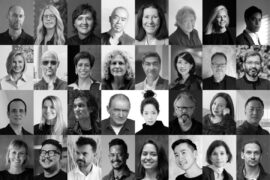The Shanghai Tower erected at the Lujiazui commercial district is set to complete mid-2015. Besides being a soaring economic symbol, the building’s innovative features look at withstanding natural disasters.

April 30th, 2015
Images: Gensler
At 632-metres tall (121 occupied floors), the futuristic and minimalistic Shanghai Tower set to complete mid-year is designed by a local team of Gensler architects to symbolise the city’s past, present and future.
The multi-purpose building comprises of nine vertical zones, each with 12-15 floors, including zones for retail, entertainment, conference, office and hotel usage. The highest, zone 9 has been kept for Observation of the cityscape.
Besides achieving the status as China’s tallest building, and the world’s second tallest, the skyscraper will also house the world’s quickest elevators designed by Mitsubishi Electric. Passengers will be whisked up to the Observation deck (level 119) at a speed faster than 18m/sec.
Asymmetrical building, tapering profile and rounded corners – these strategic features allow the building to withstand the force of typhoon winds, a natural disaster common in Shanghai. Through wind tests conducted in a Canadian lab, Gensler and a structural engineer worked on the form of the spiraling tower to reduce wind loads by 24%, achieving a lighter structure, saving $58 million on structural costs.
20,000 over curtain wall panels with more than 7,000 unique shapes creates a double skin facade. The team terms it as “mass customisation” – the components were achieved through a parametric software. Gensler had utilised the digital technology to create a system that achieves ultimate performance, as well as construction feasibility.
Suspended on cantilevered trusses and held down by hoop rings and struts, the curtain wall adds on to the complex visual effect. The inner glass facade also requires lesser glass to build, as compared to a square building of similar floor area. The transparent skin also insulates the building, reducing carbon footprint. Aside from that, a third of the vertical site will also bear extensive landscaping, serving to cool the grounds naturally.
“To create smart cities for the coming decades, we need the broad perspective a multidisciplinary design approach provides,” says Xiaomei Lee, co-managing director of Gensler Shanghai.
Besides becoming a soaring icon of Shanghai’s economic future and completing the high-rise precinct, the Shanghai Tower rises as a beacon of inspiration for future cities where the vertically stacked gathering space provides human-centric premises, as well as new ideas on how skyscrapers can be both sustainable and functional.
Gensler
gensler.com
INDESIGN is on instagram
Follow @indesignlive
A searchable and comprehensive guide for specifying leading products and their suppliers
Keep up to date with the latest and greatest from our industry BFF's!

Welcomed to the Australian design scene in 2024, Kokuyo is set to redefine collaboration, bringing its unique blend of colour and function to individuals and corporations, designed to be used Any Way!

A longstanding partnership turns a historic city into a hub for emerging talent

For Aidan Mawhinney, the secret ingredient to Living Edge’s success “comes down to people, product and place.” As the brand celebrates a significant 25-year milestone, it’s that commitment to authentic, sustainable design – and the people behind it all – that continues to anchor its legacy.

With the 2025 INDE.Awards now over, it’s time to take a breath before it all begins again in early December. However, integral to the awards this year and every year is the jury – and what an amazing group came together in 2025.

The Asia Pacific and Middle East regional leader for Gensler’s Digital Experience Design (DXD) practice discusses technology, AI, Scotland and the meaning of human-centred design in this episode of Stories Indesign.
The internet never sleeps! Here's the stuff you might have missed

Inspired by an unthinkable design challenge on Sydney Harbour, Materialised’s ingenuity didn’t just fuse acoustic performance with transparent finesse – it forever reimagined commercial curtain textiles by making the impossible possible.

The inaugural Adelaide Design Week *everywhere unfolded across five days and nights, bringing together the creative community in a way that hadn’t happened before. Organiser and regular contributor Bronwyn Marshall gives us the inside story.